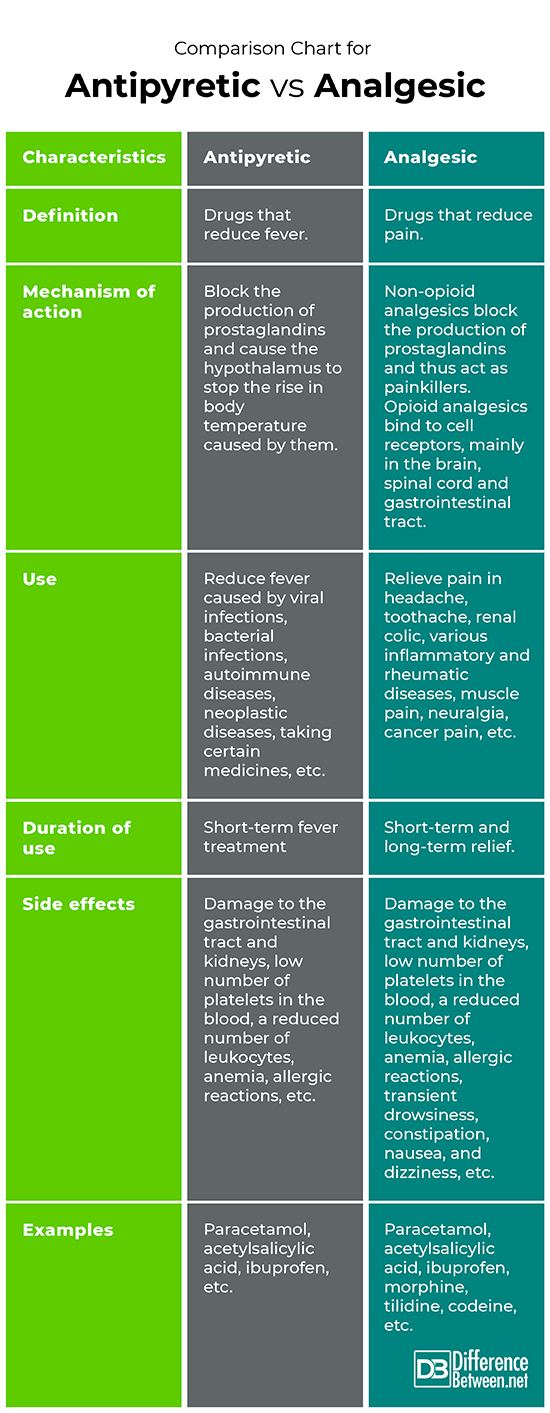Difference Between Antipyretic and Analgesic
Inflammation, pain, and fever are different manifestations of the same processes. Therefore, often the drugs used to reduce these symptoms are generally the same.
An analgesic is any medication that selectively relieves pain without blocking the conduction of nerve impulses, significantly altering sensory perception, or affecting consciousness. Antipyretics are medicinal preparations that are used to treat fever. They lower body temperature.
Analgesics are divided into two main classes – non-narcotic and opioid analgesics. Non-narcotic analgesics include antipyretics, i.e. they are preparations with analgesic and antipyretics properties.

What is Antipyretic?
Antipyretics are drugs that reduce fever. They block the production of prostaglandins and cause the hypothalamus to stop the increase in body temperature caused by them. The high temperature, regardless of its cause, hides risks of complications, dehydration, and deterioration of the general condition of the body. Together with the basic treatment, aimed at controlling the causes for the fever, antipyretics are also used. Antipyretics have also other properties, which makes them one of the most commonly used drugs in clinical practice.
Some of the most commonly used antipyretics include the following agents, which are also non-narcotic analgesics:
- Paracetamol – the safest antipyretic for children and pregnant women, leading to rapid relief of febrile symptoms;
- Acetylsalicylic acid – widely used in clinical practice as it shows also other properties (anti-inflammatory effect, analgesic effect, platelet anti-aggregation agent);
- Ibuprofen – a widely used drug with very good analgesic and antipyretic properties, etc.
It is important to clarify the etiology of the fever in order to take treatment against the specific causes that led to the onset of this symptom.
Fever can be a symptom of:
- Viral infections;
- Bacterial infections;
- Autoimmune diseases;
- Neoplastic diseases;
- Taking certain medicines, etc.
In rare cases, side effects, toxicity, and adverse drug interactions are possible. Treatment with ibuprofen can lead to damage to the gastrointestinal tract and kidneys, paracetamol in very rare cases leads to a low number of platelets in the blood, a reduced number of leukocytes with an increased chance of developing infections, anemia. Allergic reactions are possible.

What is Analgesic?
Analgesics are medications that suppress pain. They are of two main types:
- Non-narcotic analgesics, which relieve pain by reducing local inflammatory reactions;
- Opioid analgesics, which act on specific centers in the brain.
Some preparations combine non-narcotic and opioid analgesics to enhance the effect.
Non-narcotic analgesics are widely used and are available without a prescription. They are used for short-term pain relief, mainly for moderate pain, such as headaches, arthritis, toothache, etc.
Non-narcotic analgesics include the following preparations, which also have an antipyretic effect:
- Salicylic acid and its derivatives – acetylsalicylic acid (aspirin), sodium salicylate, salicylamide;
- Anilides – paracetamol, phenacetin, bucetin, propacetamol;
- Pyrazolones – metamizole sodium, phenazone, aminophenazone, nifenazone.
Unlike non-narcotic analgesics, opioids can be used for both short-term and long-term relief, and in severe pain. They have the ability to induce sleep. Opioid analgesics are often much more effective against pain, but can be addictive and are a source of greater risk of side effects. Therefore, they are usually the last resort to overcome the pain. They are only available by prescription.
The group of narcotic analgesics includes:
- Morphine;
- Tilidine;
- Codeine.
Non-opioid analgesics act on the prostaglandin system, which is responsible for the onset of pain. They block the production of prostaglandins and thus act as painkillers. Opioid analgesics bind to cell receptors, mainly in the brain, spinal cord, and gastrointestinal tract.
Side effects are rare with non-narcotic analgesics and include damage to the gastrointestinal tract and kidneys, low number of platelets in the blood, a reduced number of leukocytes with an increased chance of developing infections, anemia, allergic reactions. The main side effects of opioid analgesics are observed in the digestive system and the central nervous system. Transient drowsiness may occur with the initial onset of opioid analgesics or with increasing dose. Constipation, nausea, and dizziness are very common at the beginning of opioid use, but they are usually temporary. Allergic reactions are possible.
Difference Between Antipyretic and Analgesic
Definition
Antipyretic: Antipyretics are drugs that reduce fever.
Analgesic: Analgesics are drugs that reduce pain.
Mechanism of action
Antipyretic: Antipyretics block the production of prostaglandins and cause the hypothalamus to stop the rise in body temperature caused by them.
Analgesic: Non-opioid analgesics block the production of prostaglandins and thus act as painkillers. Opioid analgesics bind to cell receptors, mainly in the brain, spinal cord, and gastrointestinal tract.
Use
Antipyretic: Antipyretics are used to reduce fever caused by viral infections, bacterial infections, autoimmune diseases, neoplastic diseases, etc.
Analgesic: Analgesics are used to relieve pain in headache, toothache, renal colic, various inflammatory and rheumatic diseases, muscle pain, neuralgia, cancer pain, etc.
Duration of use
Antipyretic: Used for short-term fever treatment.
Analgesic: Non-narcotic analgesics are used for short-term pain relief, opioids can be used for both short-term and long-term relief.
Side effects
Antipyretic: In rare cases, side effects, toxicity, and adverse drug interactions are possible, including damage to the gastrointestinal tract and kidneys, low number of platelets in the blood, a reduced number of leukocytes with an increased chance of developing infections, anemia, allergic reactions.
Analgesic: Side effects are rare with non-narcotic analgesics (damage to the gastrointestinal tract and kidneys, low number of platelets in the blood, a reduced number of leukocytes with an increased chance of developing infections, anemia, allergic reactions). The main side effects of opioid analgesics include transient drowsiness, constipation, nausea, and dizziness, etc.
Examples
Antipyretic: Paracetamol, acetylsalicylic acid, ibuprofen, etc.
Analgesic: Paracetamol, acetylsalicylic acid, ibuprofen, morphine, tilidine, codeine, etc.
Comparison Chart for Antipyretic vs Analgesic

Summary of Antipyretic and Analgesic
- Inflammation, pain, and fever are different manifestations of the same processes. Some of the drugs used to reduce these symptoms are generally the same.
- Antipyretics are drugs that reduce fever, while analgesics are drugs that reduce pain.
- Analgesics are divided into two main classes – non-narcotic and opioid analgesics. Non-narcotic analgesics include antipyretics, i.e. they are preparations with analgesic and antipyretics properties.
- Antipyretics block the production of prostaglandins and cause the hypothalamus to stop the rise in body temperature caused by them. Non-opioid analgesics block the production of prostaglandins and thus act as painkillers. Opioid analgesics bind to cell receptors, mainly in the brain, spinal cord, and gastrointestinal tract.
- Antipyretics are used to reduce fever caused by viral infections, bacterial infections, autoimmune diseases, neoplastic diseases, taking certain medicines, etc. Analgesics are used to relieve pain in headache, toothache, renal colic, various inflammatory and rheumatic diseases, muscle pain, neuralgia, cancer pain, etc.
- Antipyretics are used for short-term fever treatment, while analgesics, depending on their type, can be used for both short-term or long-term relief.
- Possible side effects of antipyretics and non-narcotic analgesics are damage to the gastrointestinal tract and kidneys, low number of platelets in the blood, a reduced number of leukocytes with an increased chance of developing infections, anemia, allergic reactions. The main side effects of opioid analgesics include transient drowsiness, constipation, nausea, dizziness, etc.
- Examples of antipyretics are paracetamol, acetylsalicylic acid, ibuprofen, etc. Examples of analgesic are paracetamol, acetylsalicylic acid, ibuprofen, morphine, tilidine, codeine, etc.
- Difference Between Gallstones and Cholecystitis - September 5, 2021
- Difference Between Constipation and Cramping - August 4, 2021
- Difference Between Whole Genome Sequencing and Microarray - May 6, 2021
Search DifferenceBetween.net :
Leave a Response
References :
[0]Buschmann, H., T. Christoph, C. Maul, B. Sundermann (Eds.). Analgesics: From Chemistry and Pharmacology to Clinical Application. Weinheim: Wiley‐VCH Verlag GmbH. 2002. Print.
[1]Khan M., V. Verma. A Text Book Of Analgesics and Antipyretics. 2014. Print.
[2]Sinatra, R., J. Jahr, J. Pitchford (Eds.) The Essence of Analgesia and Analgesics. Cambridge: Cambridge University Press. 2011. Print.
[3]Image credit: https://live.staticflickr.com/3909/14710496068_b4b603d2cf_b.jpg
[4]Image credit: https://upload.wikimedia.org/wikipedia/commons/e/e9/Gum_paint.jpg
